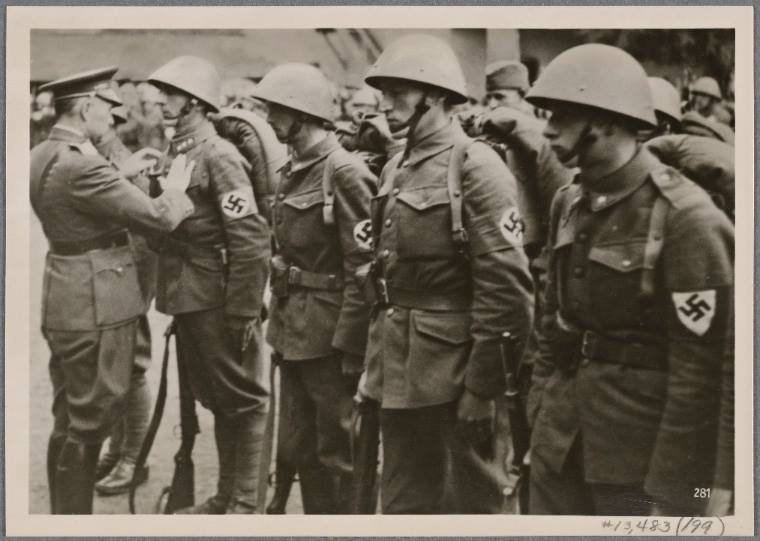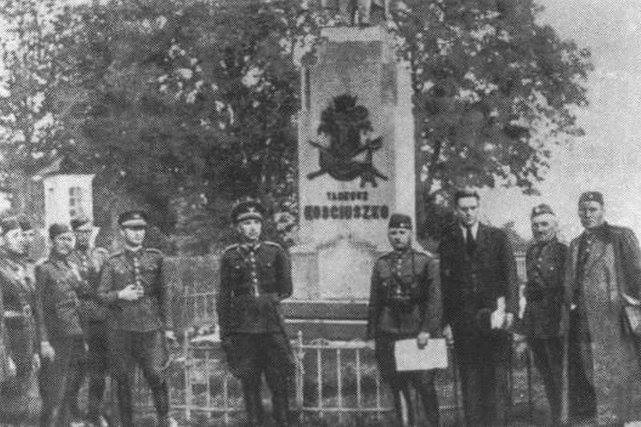
The national flag of the First Slovak Republic
When Germany invaded Poland on September 1st, 1939, Europe would be plunged into the Second World War which wouldn’t end for another six years. The Soviet Union, in accordance with the Molotov-Ribbentrop pact between the USSR and Germany, also invaded Poland beginning on September 17th, 1939. A lesser known fact was that Germany and the Soviet Union were not the only nations to invade Poland in World War Two. Slovakia, essentially a German puppet state created out of territory Germany annexed from Czechoslovakia, also partook in the invasion in limited roles.
The First Slovak Republic
The First Slovak Republic, also known as the Slovak State, received its independence on March 14th, 1939. Adolf Hitler persuaded Jozef Tiso, leader of the Slovakia region inside the remaining part of Czechoslovakia after Germany annexed the Sudetenland, to proclaim Slovakia’s independence and added that if he didn’t, Tiso couldn’t expect German assistance or support in political affairs.

Josef Tiso, president of the First Slovak Republic
Poland and Hungary had already annexed territory within Slovakia’s borders before Slovakia assisted Germany in the Invasion of Poland and if Slovakia refused to declare its independence, the region would be divided up between Hungary and Germany. After Slovakia gained its independence on the grounds that Germany would assist the new nation, border disputes between Hungary and Slovakia still occurred. In a move that caught Slovakia by surprise, Hungary attacked Slovakia without a formal declaration of war on March 23rd, 1939. Hungary was not satisfied with the new Slovakian borders and made requests for Germany to mediate negotiations between Hungary and Slovakia and award Hungary more Slovakian territory. Before any official agreement could be met and hours before Germany was to sign a treaty guaranteeing the protection of Slovakia’s borders, Hungary invaded, taking both Slovakia and Germany by surprise. Hungary made initial gains but fighting largely ceased by March 31st. On April 4th, a treaty was signed between Hungary and Slovakia, forcing Slovakia to cede a small strip of eastern territory to Hungary. Germany refused to help Slovakia during the negotiations, going against their guarantees of protection and assistance. Along with Hungary, Slovakia had numerous border disputes with Poland.
Building up to the Invasion of Poland
In 1920, Poland had been awarded some land from the Slovakian region inside Czechoslovakia after numerous border disputes. In the aftermath of the Munich Agreement of 1938 in which Germany annexed parts of Czechoslovakia, Poland had also been awarded further territory from the Slovakian region of Greater Czechoslovakia. In July, 1939, Slovakian officials engaged in secret negotiations with Germany, leading to Slovakia agreeing to partake in Germany’s invasion of Poland. Slovakia also agreed to let German troops pass through Slovakian territory. The Slovakian military was only a few months old, but Slovakia did manage to organize a sizable force. On August 26th, the Slovakian Military was mobilized. Slovakian Field Army Bernolák was assembled and was to be the main Slovakian unit used in Poland. Comprised of around 50,000 men in 3 divisions, Field Army Bernolák was led by Ferdinand Čatloš, the Slovakian Minister of Defense.

Ferdinand Čatloš, Minister of Defense of the First Slovak Republic and commanding officer of Field Army Bernolák
The unit was ultimately placed within the ranks of German Army Group South as part of the German 14th Army, under control of German Field Marshal Wilhelm List. Field Army Bernolák was mainly tasked with supporting German operations in Poland and protecting the Slovakia-Poland border.
The Invasion
In the early morning of September 1st, 1939, the Invasion of Poland begun. Field Army Bernolák began advancing into Poland as well and the 1st Division of the unit quickly occupied Tatranská Javorina, a town that Poland annexed from Czechoslovakia after the 1938 Munich Agreement. The 1st Division met some resistance and engaged Polish troops from September 4-5th as the unit traveled further into Poland, protecting a German mountain division’s left flank. By September 7th, most of the 1st Division halted their advance into Poland. The 2nd Division was given the task of mainly cleaning up areas already conquered by advancing units. The 3rd Division was tasked with protecting Slovakia’s borders, and after engaging in minor firefights, advanced into Poland. A few Slovak air squadrons also participated in the battle, mainly used for supporting German air units. By mid September, most Slovakian units in Poland had halted their advances and focused on occupying a few Polish towns that were taken in the process. Polish resistance was weakening and victory seemed nearly in sight. On October 5th in Poprad, Slovakia, a military parade was held to celebrate the success of the invasion and the Slovakian military. On October 6th, 1939, after the Battle of Kock ended in a Polish defeat, Germany and the Soviet Union now had full control of the Polish lands they had conquered although Poland never officially surrendered.

Ferdinand Čatloš decorating Slovakian soldiers after the Polish campaign in September, 1939
After the Polish Defeat
The Slovakian military suffered 37 dead and 114 wounded along with 2 aircraft destroyed during the Invasion of Poland. Field Army Bernolák returned to Slovakia after the campaign and was upgraded to a fully motorized division. The disputed territory that Poland had annexed from Slovakia in 1920 and 1938 was returned to Slovakia.

Slovakian border changes after the Invasion of Poland compared with modern Slovakia’s borders
Adolf Hitler also offered to give Slovakia control of the Polish town of Zakopane, but Slovak president Jozef Tiso rejected this offer on the grounds that no Slovaks lived there. The new territory Slovakia acquired remained in place for the duration of the war but after World War Two ended, the borders were once again redrawn, mirroring their positions in 1920.

Soldiers of the 3rd Division of Field Army Bernolák posing next to a statue of Tadeusz Kościuszko in the Polish town of Sanok in September, 1939. General Čatloš can be seen in the center of the photograph
Further Information: